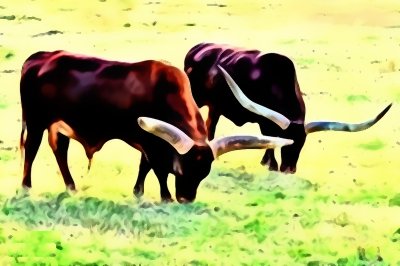
Mako Sungwapa is largely covered with vast grassy plains whose colors vary from red to yellow straw from east to west. The Aurloks explain these colorful variations with age herds that graze them.
Low red oriental herbs correspond, in their view, to spring births wild bison herds. The yellow-green grass mixed with flowers lining the Wakpa Cepe correspond to summer storms and the many rainbows in the sky that accompany them, while high white-yellow grasses northwest mark the torrid heat of Mako Skanzi the yellow desert.
 These plains are thus the area of large herbivore herds for Life for Aurloks nomadic tribes. Aurochs herds migrating from east to west to join the River–who–cries at the beginning of the hot season, herds of horses and megaceros mixed ahead of the northern mountains to spend the winter in the Great Plains and their predators, wolf packs or coyotes that gave its name to the region, Mako Sungwapa, the Land of barking.
These plains are thus the area of large herbivore herds for Life for Aurloks nomadic tribes. Aurochs herds migrating from east to west to join the River–who–cries at the beginning of the hot season, herds of horses and megaceros mixed ahead of the northern mountains to spend the winter in the Great Plains and their predators, wolf packs or coyotes that gave its name to the region, Mako Sungwapa, the Land of barking.
Many also are the nomadic tribes who follow the great herds. The vast tribe of Chant-de-la-Prairie aurochs helps to cross the Canal de la Concorde, the Children of–the–tree accompanies the flocks after the birth of the young, the tribe of the Dogs–of–the–yellow -prairie capture snakes lightning outskirts of Mako Skanzi, that of logs–of–memory maintains totems Gigage Gadusi.
 The tribes are comprised generally of fifty individuals belonging to different clans. In the Great Plains, the functions of each member are set by tradition. Males hunt Wolves and Ravens protect the herds, and Aurochs Walosi yurts are removed with the assistance of bouraks, docile and bony cattle. The females protect children, while assuming the collection and crafts, basketry and weaving their being strictly reserved elsewhere. The elders, whatever their sex, are involved in the education of children.
The tribes are comprised generally of fifty individuals belonging to different clans. In the Great Plains, the functions of each member are set by tradition. Males hunt Wolves and Ravens protect the herds, and Aurochs Walosi yurts are removed with the assistance of bouraks, docile and bony cattle. The females protect children, while assuming the collection and crafts, basketry and weaving their being strictly reserved elsewhere. The elders, whatever their sex, are involved in the education of children.
 The sachem was particularly responsible for the raising and the establishment of the camp. It meets strict traditions: laying protective totems around the camp, the town yurt installation, installation of lights …
The sachem was particularly responsible for the raising and the establishment of the camp. It meets strict traditions: laying protective totems around the camp, the town yurt installation, installation of lights …
The meeting of these tribes is always an opportunity for a powwow which are rekindled old alliances and create new friendships.
The edges of the Wakpa Cepe and freshness of its water, frequented by many tribes as soon as the heat is felt TheBus welcomes recent cycles a particular powwow: the Wanahotonyapi. To celebrate the fires TheBus, musicians from each tribe give the best of themselves in recitals which may last several nights.
In the Horn of tubal Plains tribes succeed marine conch tribes Copawige. The drum skins and wood ringers of Otsiliha follow those of lithophones of Nunoga.
Each new round sees the appearance of new instruments. The tribe of Fury des Industries has introduced an instrument consisting of finely braided tendons stretched over a hollow trunk and bent at very low tones and loved during the 1371 cycle.


